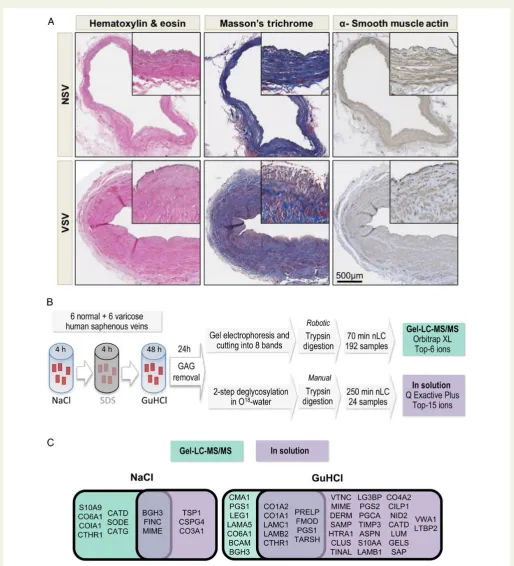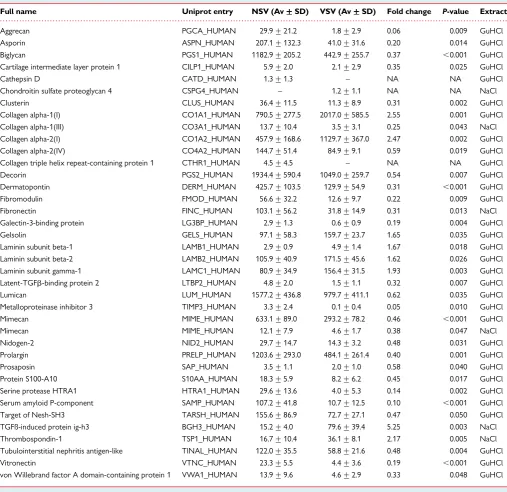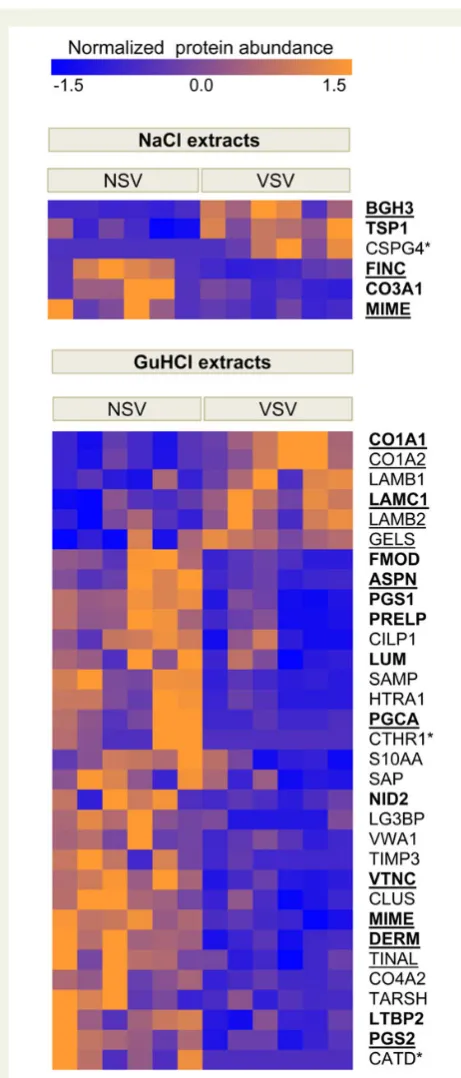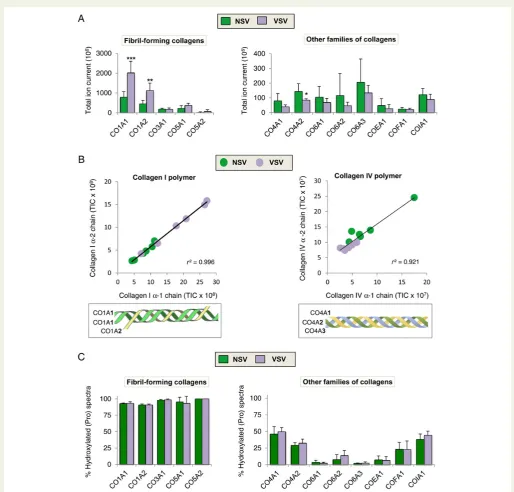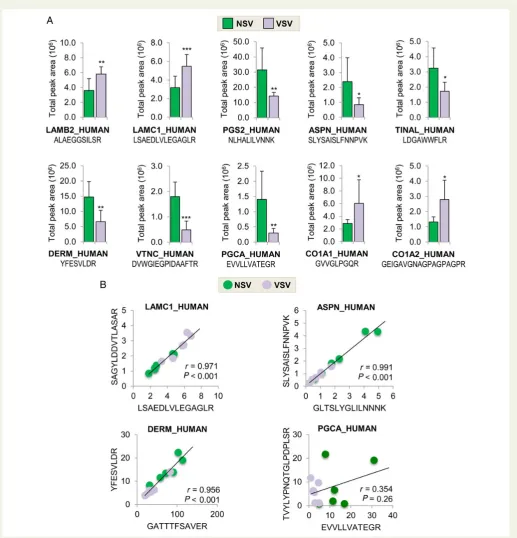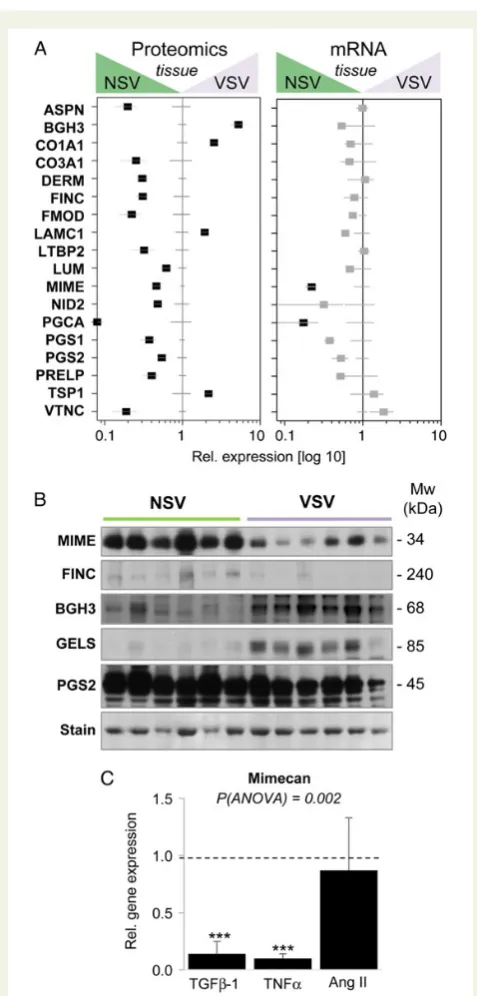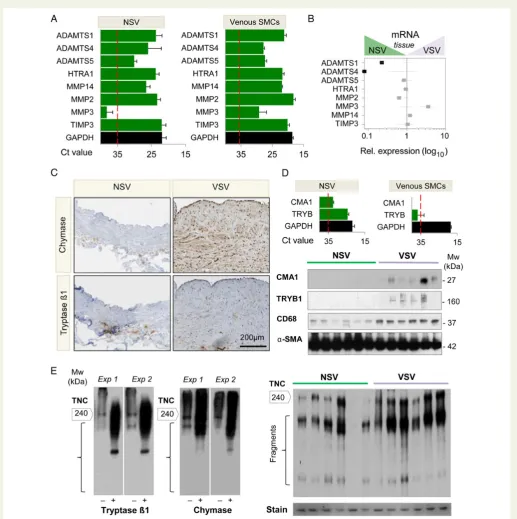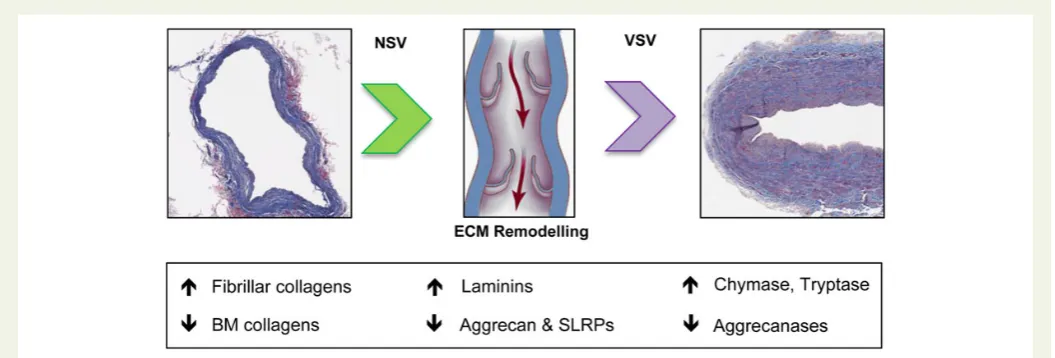. . . .
. . . .
Extracellular matrix remodelling in response
to venous hypertension: proteomics of human
varicose veins
Javier Barallobre-Barreiro
1†, Rahmi Oklu
2†, Marc Lynch
1, Marika Fava
1,3, Ferheen Baig
1,
Xiaoke Yin
1, Temo Barwari
1, David N. Potier
1, Hassan Albadawi
4, Marjan Jahangiri
3,
Karen E. Porter
5, Michael T. Watkins
4, Sanjay Misra
6, Julianne Stoughton
4,
and Manuel Mayr
1*
1
King’s British Heart Foundation Centre, King’s College London, 125 Coldharbour Lane, London SE5 9NU, UK;2
Division of Vascular and Interventional Radiology, Mayo Clinic, Scottsdale, AZ, USA;3St George’s Hospital, NHS Trust, London, UK;4Division of Vascular Surgery, Massachusetts General Hospital, Harvard Medical School, Boston, MA, USA;5Institute of Cardiovascular and Metabolic Medicine, University of Leeds, Leeds, UK; and6
Division of Vascular and Interventional Radiology, Mayo Clinic, Rochester, MN, USA
Received 17 October 2015; revised 29 February 2016; accepted 26 March 2016; online publish-ahead-of-print 11 April 2016
Time for primary review: 43 days
This manuscript was handled by a Consulting Editor.
Aims Extracellular matrix remodelling has been implicated in a number of vascular conditions, including venous hypertension and varicose veins. However, to date, no systematic analysis of matrix remodelling in human veins has been performed.
Methods and results
To understand the consequences of venous hypertension, normal and varicose veins were evaluated using proteomics approaches targeting the extracellular matrix. Varicose saphenous veins removed during phlebectomy and normal sa-phenous veins obtained during coronary artery bypass surgery were collected for proteomics analysis. Extracellular matrix proteins were enriched from venous tissues. The proteomics analysis revealed the presence of.150 extracel-lular matrix proteins, of which 48 had not been previously detected in venous tissue. Extracelextracel-lular matrix remodelling in varicose veins was characterized by a loss of aggrecan and several small leucine-rich proteoglycans and a compensatory increase in collagen I and laminins. Gene expression analysis of the same tissues suggested that the remodelling process associated with venous hypertension predominantly occurs at the protein rather than the transcript level. The loss of aggrecan in varicose veins was paralleled by a reduced expression of aggrecanases. Chymase and tryptaseb1 were among the up-regulated proteases. The effect of these serine proteases on the venous extracellular matrix was further explored by incubating normal saphenous veins with recombinant enzymes. Proteomics analysis revealed extensive extracellular matrix degradation after digestion with tryptaseb1. In comparison, chymase was less potent and degraded predominantly basement membrane-associated proteins.
Conclusion The present proteomics study provides unprecedented insights into the expression and degradation of structural
and regulatory components of the vascular extracellular matrix in varicosis.
-Keywords Venous † Extracellular matrix † Smooth Muscle † Protease
1. Introduction
Venous hypertension is among the most prevalent medical problems to-day causing significant morbidity in a variety of clinical conditions
including portal venous hypertension, haemorrhoids, pelvic congestion syndrome, nutcracker syndrome, varicose veins, and venous ulcers.1 While consequences of venous hypertension are apparent, its patho-physiology and chronic effects on the vessel wall are poorly understood,
*Corresponding author. Tel:+44 (0) 20 7848 5446; fax:+44 (0) 20 7848 5998, E-mail: manuel.mayr@kcl.ac.uk
†These authors contributed equally.
&The Author 2016. Published by Oxford University Press on behalf of the European Society of Cardiology.
limiting preventative and therapeutic options. Among the spectrum of conditions associated with venous hypertension, varicose veins in the lower extremities are the most studied because of their high prevalence and easy access to tissue for analysis. Approximately 23% of adults in the USA alone have varicose veins with significant impact on the quality of life of the patients.2There are numerous risk factors to the development of varicose veins including obesity, trauma, and pregnancy; however, genetic predisposition is probably the most important factor.3
Chronic venous reflux can lead to structural changes that ultimately cause weakening of the venous wall, resulting in dilation and a tortuous appearance. The extracellular matrix (ECM) is crucial for the structural integrity of the vessel wall. Recent advances in proteomics techniques make it feasible to characterize the composition of the ECM and its re-modelling in disease.4–6Our group has previously introduced novel proteomics methods for the analysis of ECM in clinical samples: (i) A proteomics method to characterize the arterial ECM resulting in the discovery of novel glycoproteins in the human aorta7 and (ii) a substrate-guided proteomics approach to relate the activity of specific proteases to ECM degradation products in arteries and to identify no-vel MMP targets.6,8No systematic analysis of pathological ECM remod-elling in response to venous hypertension has been performed thus far. In the present study, we explore the differences in the ECM compos-ition of normal saphenous veins (NSV) and varicose saphenous veins (VSV), and provide unprecedented insights into the expression and degradation of structural and regulatory components of the vascular ECM in varicosis.
2. Methods
See http://cardiovascres.oxfordjournals.org for an expanded description of the methods.
2.1 Subjects
The investigation conforms with the principles outlined in the Declaration of Helsinki. Following approval from the Institutional Review Board at the Mas-sachusetts General Hospital (IRB; protocol 2010P002776) and written in-formed consent, varicose great saphenous vein specimens (n¼6) were surgically removed during stab incision phlebectomy at the knee level. Nor-mal saphenous vein specimens (n¼6) were obtained by surgical resection in patients undergoing coronary artery bypass surgery; the segment of the sa-phenous vein near the knee level was collected for analysis from each patient. Clinical characteristics for all patients recruited for this study are summarized in Supplementary material online,Table S1. Both cohorts were comparable with regards to age and gender. All vein samples were immediately processed following surgical removal, i.e. adipose tissue was trimmed and blood rinsed using cold saline solution. Segments of the vein tissue from each patient were either placed in formalin for subsequent histological analysis or snap frozen in liquid nitrogen and stored at2808C for future analysis.
2.2 ECM protein enrichment
Vein tissues were subjected to our sequential extraction procedure as previously described.7In brief, vessels were washed briefly with cold PBS, incubated in 0.5 M sodium chloride (NaCl) plus proteinase and phos-phatase inhibitors for 4 h, followed by decellularization using 0.08% SDS and extraction of ECM proteins using 4 M guanidine hydrochloride (GuHCl) for 48 h before processing for proteomics analysis. Details are given in the Supplementary material online.
2.3 Mass spectrometry analysis
Before mass spectrometry analysis, tryptic peptides from processed NaCl and GuHCl extracts were separated on a nanoflow LC system
(Thermo Fisher Scientific, Ultimate 3000 RSLC nano). For gel-LC-MS/MS analysis, spectra were collected from an Orbitrap mass analyser (LTQ-Orbitrap XL, Thermo Fisher Scientific) using full ion scan mode over the mass-to-charge (m/z) range 450 – 1600. MS/MS was performed on the top six ions in each MS scan using the data-dependent acquisition mode with dynamic exclusion enabled. For in-solution LC-MS/MS analysis, spectra were collected from a Q Exactive Plus instrument (Thermo Fisher Scientific) using full MS mode over the mass-to-charge (m/z) range 350 – 1600. MS/MS was performed on the top 15 ions in each MS scan using the data-dependent acquisition mode with dynamic exclusion enabled. For multiple reaction monitoring (MRM), the column was coupled to a tri-ple quadrupole mass spectrometer (TSQ Vantage, Thermo Fisher Scientif-ic) for scheduled measurement. Skyline software (version 2.6, MacCoss Lab Software) was used to generate the transition list with predicted collision energies as well as optimized transitions and retention times. A minimum of four transitions were selected per peptide. Further details are given in the Supplementary material online.
2.4 Cell culture of human saphenous vein
smooth muscle cells
Samples of saphenous veins were collected from patients undergoing elect-ive coronary artery bypass graft surgery (n¼6) at Leeds General Infirmary. Saphenous vein smooth muscle cells (SMCs) were extracted and expanded as detailed in the Supplementary material online. SMCs were seeded into 6-well tissue culture plates. Twenty-four hours after seeding, cells were ser-um starved for 1 h. All treatments were for 24 h, and the following stimuli were diluted in serum-free DMEM at the concentrations indicated: human transforming growth factor beta-1 (TGFb-1, R&D systems) 10 ng/mL, re-combinant mouse TNFa(R&D systems) 100 ng/mL, and a synthetic pep-tide corresponding to human angiotensin II (Ang II, Sigma-Aldrich) 100 ng/mL. Changes in gene expression after stimulation were measured by RT – qPCR using probes against the corresponding human targets (for a list of all probes used, see Supplementary material online,Table S2).
2.5
In vitro
digestion of NSV
NSV (n¼5) were digested with recombinant human chymase (1mg/mL, R&D Systems) or tryptaseb1 (250 ng/mL, R&D Systems) according to the protocol supplied by the manufacturer. Controls were incubated in en-zyme buffer without enen-zyme (n¼5). After a buffer exchange, the digests were analysed by proteomics as previously described.8The proteins re-leased after digestion were concentrated and separated by SDS – PAGE. Gel separation of proteins facilitates the investigation of protein degrad-ation as protein laddering results in peptide identificdegrad-ations across multiple gel bands. The entire lane was excised, subjected to in-gel tryptic digestion, and analysed by LC-MS/MS. Evidence of degradation (P,0.05) was further validated by western blotting.
2.6 Statistical analysis
3. Results
3.1 Clinical samples
NSV and VSV were used from 12 patients (n¼6 per group). On in-spection, VSV were abnormal in appearance demonstrating character-istic dilation and tortuosity. NSV were obtained during coronary bypass surgery and showed no tortuosity or luminal dilation on inspection. Electronic medical records of each patient were reviewed for evidence of chronic venous insufficiency including imaging examinations such as ultrasound study of the lower extremities. Patients in the control group did not have a history of chronic venous insufficiency or symptoms of pain, swelling, and/or heaviness in the lower extremities. In contrast, all patients in the VSV group had documented sonographic evidence of chronic venous insufficiency and symptoms of pain, swelling, and heavi-ness in the lower extremity. The diameter of the VSV collected for ana-lysis at the knee level typically measured 5 – 6 mm with vein valve closure times ranging from 5 to 7 s indicating significant venous reflux. Both cohorts were comparable with regards to age and gender (see Supplementary material online,Table S1). Prior to molecular analysis, tissues obtained from patients were histologically evaluated to confirm the presence of venous disease (Figure1A). VSV demonstrated exten-sive neointima formation with subendothelial fibrosis, wall thickening, and luminal dilation. In contrast, venous tissue from the NSV group de-monstrated normal architecture with no evidence of neointima forma-tion or fibrosis. All tissue secforma-tions stained positive fora-smooth muscle cell actin (SMA).
3.2 Discovery proteomics of the ECM
Following confirmation of tissue histology, sequential segments of the vein tissue were processed for proteomic analysis (Figure1B). Both VSV and NSV were diced into small pieces and subjected to a three-step extraction procedure as previously described.7Vein samples were consecutively in-cubated with 0.5 M NaCl, 0.08% SDS, and 4 M GuHCl to decellularize and sequentially extract extracellular space proteins. Subsequently, two proteomics workflows were applied: firstly, NaCl and GuHCl extracts were separated by SDS–PAGE to reduce sample complexity; the entire lane was divided into a series of gel bands; and proteomic analysis was per-formed on each of them as previously described.7Secondly, NaCl and GuHCl extracts were subjected to an in-solution digest. This MS/MS da-taset was deposited in a public repository for mass spectrometry data (http://www.ebi.ac.uk/pride, project accession: PXD002555). The in-solution digest method combined with a faster, more sensitive mass spec-trometer resulted in the detection of 152 ECM proteins in the GuHCl ex-tracts and 136 in the NaCl exex-tracts, compared with 90 and 115, respectively, in the gel-LC–MS/MS approach (see Supplementary material online,Figure S1, including representative MS spectra).
3.3 ECM composition of veins
As expected by our subfractionation procedure, NaCl extracts were enriched with proteins of the extracellular space and newly synthesized ECM proteins, which are not heavily cross-linked in the interstitial matrix (see Supplementary material online, Table S3). Fibulins, ECM-associated peptidases, or fibril-associated collagens with an inter-rupted triple helix (FACITs) were already solubilized by the incubation with 0.5 M NaCl. GuHCl extracts instead contained predominantly less soluble proteins such as network-forming collagens, proteins asso-ciated with collagens, laminins, or large aggregating proteoglycans (see Supplementary material online,Table S4). Differences in protein
identifications between GuHCl and NaCl extracts are highlighted in Supplementary material online,Figure S2. Notably, 48 proteins were identified for the first time in the venous ECM (Table1; see Supplemen-tary material online,Table S5for an expanded version).
3.4 Proteomics comparison of NSV and
VSV
Overall, more differentially expressed proteins were identified in the in-solution digest (Table1; see Supplementary material online,Table S5for an expanded version) than in the gel-LC-MS/MS approach (see Supplementary material online,Table S6), and more proteins were dif-ferentially expressed in the GuHCl extracts than in the NaCl extracts
(Figure1C). In the NaCl extracts, TGFb-induced protein ig-h3 (BGH3),
a marker of TGFbactivity, and thrombospondin-1 (TSP1), a potent ac-tivator of TGFb, were up-regulated in VSV. In the GuHCl extracts, col-lagen I chainsa-1 anda-2 (CO1A1 and CO1A2) and lamininsb-1,b-2, andg-1 (LAMB1, LAMB2, and LAMC1) were increased. Most regula-tory ECM components, however, were reduced, in particular small leucine-rich proteoglycans (SLRPs) that are responsible for collagen fi-bril formation, and important for the proper formation of the vascular ECM (Figure2).
All collagens form triple helices, but resistance to tensile stress is of particular importance in collagens that contribute to fibre formation. Among these fibrillar collagens, collagens I, III, and V are abundant in the vasculature.7The increase of CO1A1 and CO1A2 (i.e. fibril-forming collagens) in VSV was in contrast to other families of collagen, which were generally decreased (Figure3A). Evidence for the quantita-tive accuracy of our proteomic method is the strong correlation (r. 0.9) between the abundance of different collagen subunits (Figure3B). Hydroxylation of collagen on prolines within X-Pro-Gly triplets is a key process during fibre formation.9On average, 96% of peptides be-longing to fibrillar collagens contained this post-translational modifica-tion. Hydroxylation was less abundant in other collagens (Figure3C). Although detectable, hydroxylated Pro-Hyp-Gly sequences, which are targets for prolyl-3-hydroxylase,9and hydroxylation of lysine10 were less common (see Supplementary material online,Figure S3). No differences were observed in collagen hydroxylation between NSV and VSV.
3.5 Validation with targeted proteomics
We took advantage of our MS data from different cardiovascular terri-tories5–8and selected additional proteotypic peptides for targeted MRM analysis (see Supplementary material online,Figure S4andTable S7) to confirm the increase in LAMB2 and LAMC1, and the loss of dec-orin (PGS2), aspdec-orin (ASPN), tubulointerstitial nephritis antigen-like protein (TINAL), dermatopontin (DERM), vitronectin (VTNC), and ag-grecan (PGCA) in VSV. The aforementioned increase of CO1A1 and CO1A2 in VSV was also confirmed by MRM analysis (Figure4A). The accuracy of our MRM method was demonstrated by selecting two dif-ferent proteotypic peptides for the same protein (Figure4B). For most proteins, the correlation between the two different peptides for the same protein was high (i.e.r.0.95). An exception was aggrecan, prob-ably because the selected peptides were on opposite sites of a com-mon aggrecanase cleavage site.
3.6 Validation by independent techniques
corresponding changes in gene expression (Figure5A). Only the down-regulation of mimecan (MIME) and aggrecan (PGCA) in VSV was observed at the protein as well as the transcript level. The loss of fibronectin (FINC,Table1) and galectin-1 in VSV (see Supplementary material online,Table S6) was corroborated by immunohistochemistry
(see Supplementary material online,Figure S5). Additional immunoblots were performed for mimecan, fibronectin, TGFb-induced protein ig-h3, gelsolin (GELS), and decorin to confirm the changes in protein abundance (Figure5B; see Supplementary material online,Figure S5
[image:4.595.39.554.54.621.2]for quantification by densitometry). The down-regulation of mimecan
was further validated by using venous human SMCs stimulated with TGFb-1, TNFa, or Ang II. TGFb-1 and TNFa, but not Ang II, were able to induce a repression of mimecan gene expression (Figure5C).
3.7 Proteolytic degradation of the venous
ECM
Apart from collagen I and laminins, many ECM proteins were down-regulated in the GuHCl fraction of VSV compared with NSV, including the large aggregating proteoglycan aggrecan. Gene expression analysis demonstrated that aggrecanases from the ADAMTS (a disintegrin
metalloproteinase with thrombospondin domains) family (ADAMTS1, 4, 5) are expressed in veins as well as venous SMCs (Figure6A). Along with aggrecan, transcript levels for ADAMTS1 and ADAMTS4 were reduced in VSV (Figure 6B). Other proteases screened and the protease inhibitor TIMP3 did not show a significant change.
Thus, we searched for additional proteases in our proteomics data-set. Two mast cell proteases were identified in VSV: chymase and tryp-taseb1. Both tryptaseb1 and chymase could be localized in the neointima of VSV. However, the staining pattern revealed a different lo-calization within the vessel wall. Tryptaseb1-positive cells were mainly localized in the adventitia of the vessel wall, whereas chymase staining
[image:5.595.45.553.73.565.2]. . . . Table 1 ECM proteins with differential abundance between NSV and VSV based on in-solution digests
Full name Uniprot entry NSV (Av+++++SD) VSV (Av+++++SD) Fold change P-value Extract
Aggrecan PGCA_HUMAN 29.9+21.2 1.8+2.9 0.06 0.009 GuHCl
Asporin ASPN_HUMAN 207.1+132.3 41.0+31.6 0.20 0.014 GuHCl
Biglycan PGS1_HUMAN 1182.9+205.2 442.9+255.7 0.37 ,0.001 GuHCl
Cartilage intermediate layer protein 1 CILP1_HUMAN 5.9+2.0 2.1+2.9 0.35 0.025 GuHCl
Cathepsin D CATD_HUMAN 1.3+1.3 – NA NA GuHCl
Chondroitin sulfate proteoglycan 4 CSPG4_HUMAN – 1.2+1.1 NA NA NaCl
Clusterin CLUS_HUMAN 36.4+11.5 11.3+8.9 0.31 0.002 GuHCl
Collagen alpha-1(I) CO1A1_HUMAN 790.5+277.5 2017.0+585.5 2.55 0.001 GuHCl
Collagen alpha-1(III) CO3A1_HUMAN 13.7+10.4 3.5+3.1 0.25 0.043 NaCl
Collagen alpha-2(I) CO1A2_HUMAN 457.9+168.6 1129.7+367.0 2.47 0.002 GuHCl
Collagen alpha-2(IV) CO4A2_HUMAN 144.7+51.4 84.9+9.1 0.59 0.019 GuHCl
Collagen triple helix repeat-containing protein 1 CTHR1_HUMAN 4.5+4.5 – NA NA GuHCl
Decorin PGS2_HUMAN 1934.4+590.4 1049.0+259.7 0.54 0.007 GuHCl
Dermatopontin DERM_HUMAN 425.7+103.5 129.9+54.9 0.31 ,0.001 GuHCl
Fibromodulin FMOD_HUMAN 56.6+32.2 12.6+9.7 0.22 0.009 GuHCl
Fibronectin FINC_HUMAN 103.1+56.2 31.8+14.9 0.31 0.013 NaCl
Galectin-3-binding protein LG3BP_HUMAN 2.9+1.3 0.6+0.9 0.19 0.004 GuHCl
Gelsolin GELS_HUMAN 97.1+58.3 159.7+23.7 1.65 0.035 GuHCl
Laminin subunit beta-1 LAMB1_HUMAN 2.9+0.9 4.9+1.4 1.67 0.018 GuHCl
Laminin subunit beta-2 LAMB2_HUMAN 105.9+40.9 171.5+45.6 1.62 0.026 GuHCl
Laminin subunit gamma-1 LAMC1_HUMAN 80.9+34.9 156.4+31.5 1.93 0.003 GuHCl
Latent-TGFb-binding protein 2 LTBP2_HUMAN 4.8+2.0 1.5+1.1 0.32 0.007 GuHCl
Lumican LUM_HUMAN 1577.2+436.8 979.7+411.1 0.62 0.035 GuHCl
Metalloproteinase inhibitor 3 TIMP3_HUMAN 3.3+2.4 0.1+0.4 0.05 0.010 GuHCl
Mimecan MIME_HUMAN 633.1+89.0 293.2+78.2 0.46 ,0.001 GuHCl
Mimecan MIME_HUMAN 12.1+7.9 4.6+1.7 0.38 0.047 NaCl
Nidogen-2 NID2_HUMAN 29.7+14.7 14.3+3.2 0.48 0.031 GuHCl
Prolargin PRELP_HUMAN 1203.6+293.0 484.1+261.4 0.40 0.001 GuHCl
Prosaposin SAP_HUMAN 3.5+1.1 2.0+1.0 0.58 0.040 GuHCl
Protein S100-A10 S10AA_HUMAN 18.3+5.9 8.2+6.2 0.45 0.017 GuHCl
Serine protease HTRA1 HTRA1_HUMAN 29.6+13.6 4.0+5.3 0.14 0.002 GuHCl
Serum amyloid P-component SAMP_HUMAN 107.2+41.8 10.7+12.5 0.10 ,0.001 GuHCl
Target of Nesh-SH3 TARSH_HUMAN 155.6+86.9 72.7+27.1 0.47 0.050 GuHCl
TGFß-induced protein ig-h3 BGH3_HUMAN 15.2+4.0 79.6+39.4 5.25 0.003 NaCl
Thrombospondin-1 TSP1_HUMAN 16.7+10.4 36.1+8.1 2.17 0.005 NaCl
Tubulointerstitial nephritis antigen-like TINAL_HUMAN 122.0+35.5 58.8+21.6 0.48 0.004 GuHCl
Vitronectin VTNC_HUMAN 23.3+5.5 4.4+3.6 0.19 ,0.001 GuHCl
von Willebrand factor A domain-containing protein 1 VWA1_HUMAN 13.9+9.6 4.6+2.9 0.33 0.048 GuHCl
Average+standard deviation (Av+SD) based on total ion current (TIC×10 to the power of 6).
P-values were derived from unpaired Student’st-tests with unequal variance (Note that every time protein expression in the majority of samples from 1 of the 2 groups compared was
was seen throughout the vessel wall (Figure6Cand see Supplementary material online,Figure S6). Gene expression analysis showed that both chymase and tryptaseb1 were expressed in tissue samples but not in
cultured human venous SMCs (Figure6D,top panel), even when stimu-lated with TGFb-1, TNFa, and Ang II (data not shown). Instead, the in-creased abundance of these mast cell proteases in VSV was paralleled by an increase in CD68, a marker for the various cells of the macro-phage lineage, and a decrease ofa-SMA (Figure6D, lower panel; see Supplementary material online, Figure S6 for quantification by densitometry).
To investigate the effect in venous tissue of tryptaseb1 and chymase, NSV macroscopically free of vascular disease were subjected to an overnight digestion with tryptaseb1 and chymase. NSV incubated in enzyme buffer-only were used as controls. The proteins released after digestion were analysed by gel-LC-MS/MS (see Supplementary material online,Figure S7). Extracellular proteins detected after chymase and tryptaseb1 digestion of NSV are listed in Supplementary material on-line,Table S8andTable S9, respectively. The effect of the treatment with tryptaseb1 and chymase on the distribution of various protease targets is presented in the Supplementary material online,Figure S8. The in-gel approach allowed assignments of fragments from ECM pro-teins identified in bands lower than their expected molecular weights (Mw) resulting in higher spectral counts or a shift in their Mw distribu-tion. Only for small proteins like galectin-1 (14 kDa), fragments were not detected upon digestion, probably due to migration ahead of the gel front. Notably, the effect of tryptaseb1 on the venous ECM was generally more pronounced (see Supplementary material online,Table S10). Basement membrane (BM)-associated proteins, such as collagen VI, perlecan, and tenascins, however, were predominantly affected by digestion with chymase. In contrast, no effect was observed on CO1A1 and CO1A2, suggesting that increased chymase levels cannot attenuate collagen I accumulation in VSV. For independent validation, we performed immunoblotting for tenascin C on the conditioned medium after digestion with tryptaseb1 and chymase. Degradation was observed following incubation with both proteases (Figure6E, left panel), and a similar degradation pattern was observed in VSV
(Figure6E,right panel). Thus, besides changes in gene expression,
remodelling in VSV involves proteolysis of ECM components.
4. Discussion
In continuation of our previous work on applying proteomics to study the cardiovascular ECM,5–8this is the first proteomics analysis of the ECM in human veins that describes the remodelling process of the venous ECM, a critical step in the development of varicosis. The key proteomic findings are summarized inFigure7.
4.1 ECM remodelling in veins
[image:6.595.38.269.49.589.2]Venous hypertension in the hepatic, splanchnic, and peripheral circula-tion affects a large populacircula-tion of patients presenting with liver, renal, and cardiovascular disease. Although the causes of venous hyperten-sion may be multifactorial, epigenetic factors at the level of the venous wall may also be involved in mediating susceptibility. Varicose veins are among the most prevalent medical problems today with worldwide prevalence estimates of up to 73% in females and 56% in males.11It is associated with significant morbidity and has a considerable econom-ic impact causing an estimated loss of 2 million workdays and costing $3 billion to treat in the USA alone.12The pathogenesis of varicose veins is associated with many predisposing factors including pregnancy, trauma, obesity, and prolonged standing. However, it is becoming increasingly apparent that its development is more complex, likely
involving inborn, epigenetic, or local genetic traits that probably play key roles in increasing susceptibility to developing varicose veins.3
Until now, a comprehensive analysis of ECM components compris-ing NSV and VSV has not been performed. In recent years, our group has used proteomics to study ECM remodelling in different cardiovas-cular diseases, including in aortic specimen.5,6,13 Compared with other tissues, the decellularization step is a key to reduce complexity and minimize carryover from cell- and blood-derived proteins in
[image:7.595.41.556.55.547.2]cardiovascular tissues.14A caveat of the gel-LC-MS/MS approach is the fact that very large ECM proteins may not migrate into the gel.15 On the other hand, the presence of these high Mw proteins can mask the presence of less abundant ECM proteins since they generate far more tryptic peptides than low Mw proteins. Similarly, in the pre-sent study, both approaches revealed interesting and complimentary protein changes that were validated by independent techniques, including western blot and MRM analysis.
In VSV, the perivascular space is surrounded by ECM proteins. This perivascular cuff is an initial response to an increased mechanical load and is accompanied by collagen deposition. However, the collagen fibres show abnormal distribution and morphology. Immunohisto-chemical analyses demonstrated that VSV had irregular collagen
[image:8.595.40.558.53.592.2]fibrillogenesis and redundant lamellae of BM material.16Our proteo-mics results corroborate these histological findings by demonstrating an increase in collagen I chains and laminins in VSV. Other BM proteins and collagen-binding proteins required for assembly, size, and structure of collagen fibres showed a marked reduction in chronic venous
insufficiency. TGFb-induced protein ig-h3, a downstream marker for TGFbactivity, and thrombospondin-1, a key activator of TGFb, were increased confirming previous reports of exacerbated levels of local TGFbin VSV.17In addition, our proteomics study revealed a decrease in SLRPs.18All detected SLRPs in venous vessels (decorin, mimecan, bi-glycan, fibromodulin, prolargin, lumican, asporin, and podocan) have horseshoe shapes and embrace collagen fibres to ensure appropriate calibre, shape, and disposition.19Furthermore, decorin, biglycan, fibromodulin, and asporin bind TGFb, repressing the activation of pro-fibrotic pathways.18Reduced levels of SLRPs with TGFb-binding activity and of TGFb-sequestering proteins such as cartilage intermedi-ate layer protein 1 (CILP1,Figure2) support the notion of exacerbated TGFbactivity in chronic venous insufficiency.17Moreover, our data show that in venous SMCs, expression of other SLRPs such as mimecan is responsive not only to the pro-fibrotic cytokine TGFb-1, but also to the pro-inflammatory cytokine TNFa, which is known to be elevated in patients with venous ulcers.20
4.2 Vascular proteases
MMPs with their broad substrate specificity8have been identified as key drivers of ECM degradation, in particular during the earlier stages of venous remodelling.21Decreased protein levels of TIMP3 (i.e. a broad spectrum matrix-associated metalloproteinase inhibitor) detected in our proteomics analysis of the GuHCl extracts (Table1), support the concept of increased proteolytic activity in venous hypertension. TIMP3, however, was not altered at the transcript level (Figure6B) but has previously been implicated in preserving the vascular ECM in arterial hypertension.22Additional metalloproteinases include aggreca-nases from the ADAMTS family. The ADAMTS enzymes are secreted, multi-domain zinc metalloendopeptidases with diverse roles in physio-pathological remodelling, inflammation, and vascular biology.23 Interestingly, aggrecan, a major ECM component of cartilage, has pre-viously been identified in aortic tissue.7Negatively charged glycans on the surface of aggrecan attract water and therefore confer resistance to compression. To our knowledge, the present study is the first to report the identification of aggrecan in venous tissue. Expression of aggrecan in VSV was reduced at the protein and transcript levels in comparison to NSV. The loss of aggrecan was accompanied by a reduction of aggrecanase expression (ADAMTS1 and ADAMTS4).
Our proteomics analyses returned additional proteases, including chymase and tryptaseb1. These serine proteases are commonly attrib-uted to secretory granules of mast cells and promote inflammation and ECM remodelling.24,25Although one study reported no significant difference in the mean mast cell density in the wall of varicose and non-dilated veins,26several groups have demonstrated that mast cells are a predominant cell type in VSV.27Intriguingly, chymase staining in VSV rarely co-localised with tryptaseb1 (Figure6C). The presence of a vascular SMC-expressed chymase has previously been reported in ar-teries of spontaneously hypertensive rats.28,29While the observed staining pattern was suggestive of an ubiquitous presence of chymase in VSV, including SMCs, the lack of chymase expression in cultured ven-ous human SMCs is evidence to the contrary, and stimulation with TGFb-1, Ang II, and TNFafailed to induce expression (data not shown). Although we observed increased abundance of the macro-phage lineage marker CD68 in VSV, a recent paper by Shankman
et al.30demonstrated that expression of CD68 and other non-SMC
[image:9.595.41.280.48.547.2]markers can be induced in SMCs within atherosclerotic plaques. Thus, lineage tracing rather than co-staining is required to establish cellular origin in diseased tissues.
Apart from a chymase-dependent Ang II-generating pathway in the vessel wall,28,31there are several other mechanisms by which chymases may impact on blood vessels and in particular affect SMCs.32For ex-ample, Leskinenet al.33,34demonstrated that chymase is pro-apoptotic for vascular SMCs by degrading the pericellular ECM component fibro-nectin, causing disruption of focal adhesion complexes and Akt depho-sphorylation, which are necessary for cell adhesion and survival. Similarly, we have observed fibronectin degradation and preferential release of BM proteins by chymase digestion of NSV. On the other hand, there are endogenous protease inhibitors in the interstitial fluid that would inhibit chymase activity.35The importance of proteolytic ac-tivity for the wall stress-induced maladaptive venous remodelling has been highlighted by a recent study; inhibition of the 26S proteasome using bortezomib led to a stabilization of the quiescent SMC pheno-type. Bortezomib inhibits the chymotrypsin-like activity of the 26S pro-teasome, and transdermal administration diminished venous SMC proliferation by 80% and inhibited varicose-like venous remodelling in a mouse model.36 Notably, chymases have chymotrypsin-like substrate specificity.
4.3 Strengths and limitations
A strength of the study is the use of well-characterized patient samples. A caveat of working with patient specimens is that only end-stage dis-ease can be assessed. Therefore, future studies to clarify the temporal expression and activity patterns of vascular proteases will be required. To that end, animal models offer unique insights into disease progres-sion. Although mast cells have been shown to play detrimental roles in the pathogenesis of both atherosclerosis37and abdominal aortic aneur-ysm,38mast cell chymase can also prevent an exaggerated SMC expan-sion.25,34Further studies are required to explore the role and cellular localization of chymase in VSV. Moreover, our proteomics workflow targets extracellular proteins, but released proteins do not necessarily reflect intracellular protein concentrations. For example, increased levels of cathepsins have been observed in VSV.39
In conclusion, varicosis is intimately related to dynamic changes in the vascular ECM and its associated proteins. The present proteomics study provides the first comprehensive analysis of the ECM remodelling processes in response to venous hypertension.
Supplementary material
Supplementary material is available atCardiovascular Researchonline.
Acknowledgements
We thank Dr Athanasios Didangelos for technical assistance and Dr Sarah Langley for help with statistical analysis.
Conflict of interest:none declared.
Funding
This work was supported by the American College of Phlebology (R.O.) and the National Institute for Health Research (NIHR) Biomedical Re-search Centre based at Guy’s and St Thomas’ NHS Foundation Trust and King’s College London in partnership with King’s College Hospital and an excellence initiative (Competence Centers for Excellent Technologies -COMET) of the Austrian Research Promotion Agency FFG: ‘Research Cen-ter of Excellence in Vascular Ageing – Tyrol, VASCage’ (K-Project Nr. 843536) funded by the BMVIT, BMWFW, the Wirtschaftsagentur Wien, and the Standortagentur Tirol. H.A. is funded by Massachusetts General Hospital, Department of Surgery, Division of Vascular and Endovascular Surgery, Henry & Nod Meyer Research Fund. M.M. is a Senior Fellow of the British Heart Foundation.
References
1. Oklu R, Habito R, Mayr M, Deipolyi AR, Albadawi H, Hesketh R, Walker TG, Linskey KR, Long CA, Wicky S, Stoughton J, Watkins MT. Pathogenesis of varicose veins.J Vasc Interv Radiol2012;23:33 – 39.
2. Hamdan A. Management of varicose veins and venous insufficiency.JAMA2012;308: 2612 – 2621.
3. Bharath V, Kahn SR, Lazo-Langner A. Genetic polymorphisms of vein wall remodeling in chronic venous disease: a narrative and systematic review.Blood2014;124:1242 – 1250. 4. Barallobre-Barreiro J, Didangelos A, Yin X, Dome´nech N, Mayr M. A sequential extrac-tion methodology for cardiac extracellular matrix prior to proteomics analysis.Methods
Mol Biol2013;1005:215 – 223.
5. Barallobre-Barreiro J, Didangelos A, Schoendube FA, Drozdov I, Yin X, Ferna´ndez-Caggiano M, Willeit P, Puntmann VO, Aldama-Lo´pez G, Shah AM, Dome´nech N, Mayr M. Proteomics analysis of cardiac extracellular matrix remodeling in a porcine model of ischemia/reperfusion injury.Circulation2012;125:789 – 802. 6. Didangelos A, Yin X, Mandal K, Saje A, Smith A, Xu Q, Jahangiri M, Mayr M. Extracellular
matrix composition and remodeling in human abdominal aortic aneurysms: a proteo-mics approach.Mol Cell Proteomics2011;10:M111. 008128.
[image:11.595.36.564.55.234.2]7. Didangelos A, Yin X, Mandal K, Baumert M, Jahangiri M, Mayr M. Proteomics character-ization of extracellular space components in the human aorta.Mol Cell Proteomics2010; 9:2048 – 2062.
8. Stegemann C, Didangelos A, Barallobre-Barreiro J, Langley S, Mandal K, Jahangiri M, Mayr M. Proteomic identification of matrix metalloproteinase substrates in the human vasculature.Circ Cardiovasc Genet2013;6:106 – 117.
9. Pokidysheva E, Boudko S, Vranka J, Zientek K, Maddox K, Moser M, Fa¨ssler R, Ware J, Ba¨chinger HP. Biological role of prolyl 3-hydroxylation in type IV collagen.Proc Natl
Acad Sci USA2014;111:161 – 166.
10. Yamauchi M, Sricholpech M. Lysine post-translational modifications of collagen.Essays
Biochem2012;52:113 – 133.
11. Beebe-Dimmer JL, Pfeifer JR, Engle JS, Schottenfeld D. The epidemiology of chronic venous insufficiency and varicose veins.Ann Epidemiol2005;15:175 – 184.
12. McGuckin M, Waterman R, Brooks J, Cherry G, Porten L, Hurley S, Kerstein MD. Validation of venous leg ulcer guidelines in the United States and United Kingdom.
Am J Surg2002;183:132 – 137.
13. Drozdov I, Didangelos A, Yin X, Zampetaki A, Abonnenc M, Murdoch C, Zhang M, Ouzounis CA, Mayr M, Tsoka S, Shah AM. Gene network and proteomic analyses of cardiac responses to pathological and physiological stress.Circ Cardiovasc Genet2013; 6:588 – 597.
14. Wilson R, Norris EL, Brachvogel B, Angelucci C, Zivkovic S, Gordon L, Bernardo BC, Stermann J, Sekiguchi K, Gorman JJ, Bateman JF. Changes in the chondrocyte and extra-cellular matrix proteome during post-natal mouse cartilage development.Mol Cell
Pro-teomics2012;11:M111. 014159.
15. Wu YJ, La Pierre DP, Wu J, Yee AJ, Yang BB. The interaction of versican with its binding partners.Cell Res2005;15:483 – 494.
16. Higley H, Ksander G, Gerhardt C, Falanga V. Extravasation of macromolecules and pos-sible trapping of transforming growth factor-bin venous ulceration.Br J Dermatol1995; 132:79 – 85.
17. Badier-Commander C, Couvelard A, Henin D, Verbeuren T, Michel JB, Jacob MP. Smooth muscle cell modulation and cytokine overproduction in varicose veins. An in situ study.J Pathol2001;193:398 – 407.
18. Merline R, Schaefer RM, Schaefer L. The matricellular functions of small leucine-rich proteoglycans (SLRPs).J Cell Commun Signal2009;3:323 – 335.
19. Chen S, Birk DE. The regulatory roles of small leucine – rich proteoglycans in extracel-lular matrix assembly.FEBS J2013;280:2120 – 2137.
20. Murphy MA, Joyce WP, Condron C, Bouchier-Hayes D. A reduction in serum cytokine levels parallels healing of venous ulcers in patients undergoing compression therapy.
Eur J Vasc Endovasc Surg2002;23:349 – 352.
21. Kucukguven A, Khalil RA. Matrix metalloproteinases as potential targets in the venous dilation associated with varicose veins.Curr Drug Targets2013;14:287.
22. Basu R, Lee J, Morton JS, Takawale A, Fan D, Kandalam V, Wang X, Davidge ST, Kassiri Z. TIMP3 is the primary TIMP to regulate agonist-induced vascular remodelling and hypertension.Cardiovasc Res2013;98:360 – 371.
23. Kelwick R, Desanlis I, Wheeler GN, Edwards DR. The ADAMTS (A Disintegrin and Metalloproteinase with Thrombospondin motifs) family.Genome Biol2015;16:113.
24. Kinoshita M, Okada M, Hara M, Furukawa Y, Matsumori A. Mast cell tryptase in mast cell granules enhances MCP-1 and interleukin-8 production in human endothelial cells.
Arterioscler Thromb Vasc Biol2005;25:1858 – 1863.
25. Leskinen M, Wang Y, Leszczynski D, Lindstedt KA, Kovanen PT. Mast cell chymase induces apoptosis of vascular smooth muscle cells.Arterioscler Thromb Vasc Biol2001; 21:516 – 522.
26. Haviarova´ Z, Weismann P, Pavlı´kova´ D, Durdı´k Sˇ, Kova´cˇ P, Sˇtvrtinova´ V, Mra´z P. Mast cell infiltration in the wall of varicose veins.Acta Histochem2002;104:357 – 360. 27. Sayer G, Smith P. Immunocytochemical characterisation of the inflammatory cell
infiltrate of varicose veins.Eur J Vasc Endovasc Surg2004;28:479 – 483.
28. Guo C, Ju H, Leung D, Massaeli H, Shi M, Rabinovitch M. A novel vascular smooth muscle chymase is upregulated in hypertensive rats.J Clin Invest2001;107:703. 29. Ju H, Gros R, You X, Tsang S, Husain M, Rabinovitch M. Conditional and targeted
over-expression of vascular chymase causes hypertension in transgenic mice.Proc Natl Acad
Sci USA2001;98:7469 – 7474.
30. Shankman LS, Gomez D, Cherepanova OA, Salmon M, Alencar GF, Haskins RM, Swiatlowska P, Newman AA, Greene ES, Straub AC, Isakson B, Randolph GJ, Owens GK. KLF4-dependent phenotypic modulation of smooth muscle cells has a key role in atherosclerotic plaque pathogenesis.Nat Med2015;21:628 – 637. 31. Miyazaki M, Takai S, Jin D, Muramatsu M. Pathological roles of angiotensin II produced
by mast cell chymase and the effects of chymase inhibition in animal models.Pharmacol Ther2006;112:668 – 676.
32. Waern I, Jonasson S, Hjoberg J, Bucht A, A˚ brink M, Pejler G, Wernersson S. Mouse mast cell protease 4 is the major chymase in murine airways and has a protective role in allergic airway inflammation.J Immunol2009;183:6369 – 6376.
33. Leskinen MJ, Heikkila¨ HM, Speer MY, Hakala JK, Laine M, Kovanen PT, Lindstedt KA. Mast cell chymase induces smooth muscle cell apoptosis by disrupting NF-kB-mediated survival signaling.Exp Cell Res2006;312:1289 – 1298.
34. Leskinen MJ, Lindstedt KA, Wang Y, Kovanen PT, Lindstedt KA. Mast cell chymase in-duces smooth muscle cell apoptosis by a mechanism involving fibronectin degradation and disruption of focal adhesions.Arterioscler Thromb Vasc Biol2003;23:238 – 243. 35. Kokkonen JO, Lindstedt KA, Kovanen PT. Role for chymase in heart failure angiotensin
II-dependent or-independent mechanisms?Circulation2003;107:2522 – 2524. 36. Pfisterer L, Meyer R, Feldner A, Drews O, Hecker M, Korff T. Bortezomib protects
from varicose-like venous remodeling.FASEB J2014;28:3518 – 3527.
37. Metzler B, Xu Q. The role of mast cells in atherosclerosis.Int Arch Allergy Immunol1997; 114:10 – 14.
38. Sun J, Zhang J, Lindholt JS, Sukhova GK, Liu J, He A, A˚ brink M, Pejler G, Stevens RL, Thompson RW, Ennis TL, Gurish MF, Libby P, Shi G-P. Critical role of mast cell chymase in mouse abdominal aortic aneurysm formation.Circulation2009;120:973 – 982. 39. Xu N, Zhang Y-Y, Lin Y, Bao B, Zheng L, Shi G-P, Liu J. Increased levels of lysosomal
